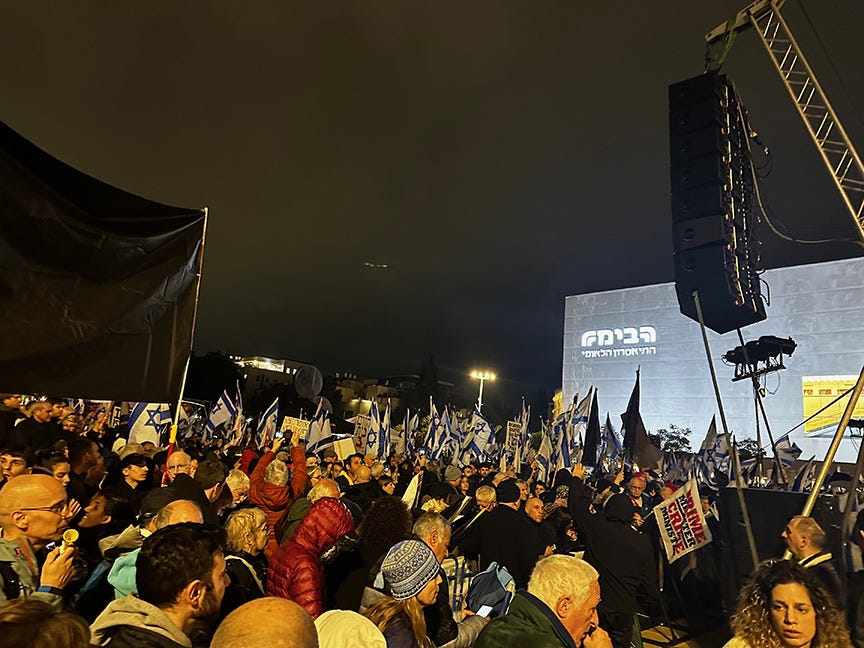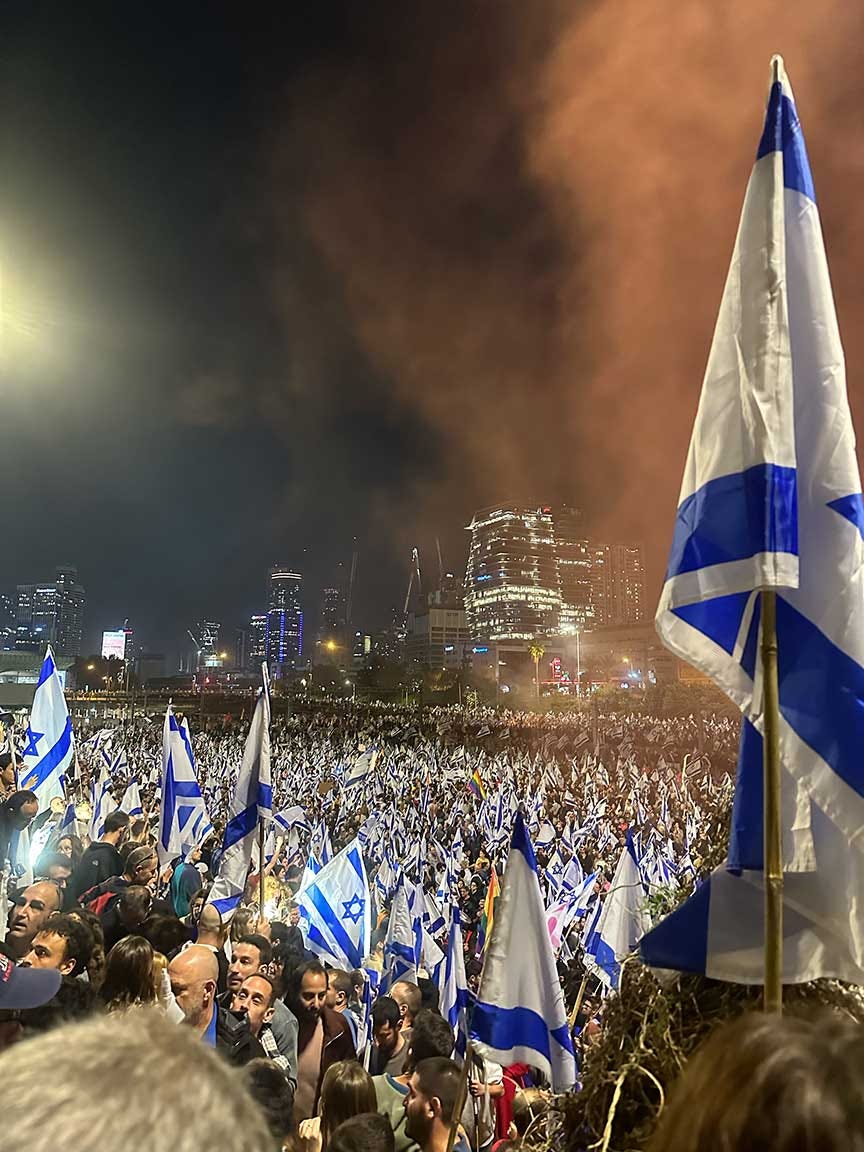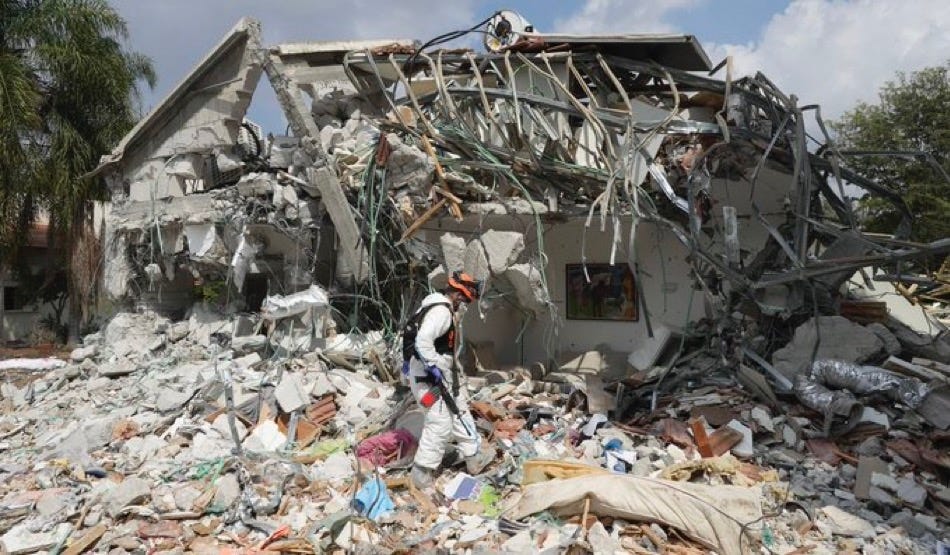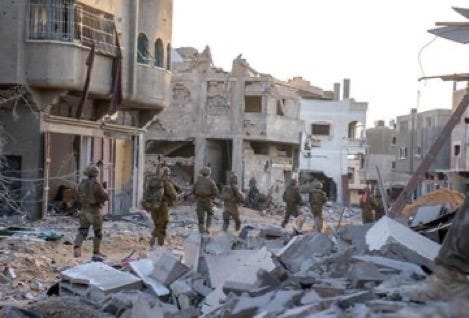When I hit 'publish' on the Update tonight, a New Year will have arrived in Israel, soon to be followed around the rest of the world. I don't know any Israeli who isn't eager to bid farewell to 2023; which has undoubtedly been the worst year in Israel's history. For Israel, the first tumultuous events of year began just a few days prior to the New Year (December 29, 2022), marked by the swearing-in of the new government. At the time, I wrote in Newsweek that Israel's worst enemy is its new coalition. Albeit with great sadness, little did I know how correct I was, and how soon the new government would wage war on its own citizens. This internal war led, in part, to the worst day in our history, and propelled us into an ongoing war, with no end in sight.
The government, sworn in on December 28th, was inherently problematic. To form it, Netanyahu made indefensible agreements and placed individuals in positions of power who, just two years earlier, he vowed would never be part of his government.
It was clear this new government was a government like no other, lacking any centrists to moderate its actions. While for the first few days of the new coaliton’s term in office, the lack of political balance was only a theoretical concern. On January 5th, our theoretical concern became a stark reality. On that day, the new Minister of Justice, Yariv Levin, delivered a prime-time address announcing the government's plan for “Judicial Reform,” making it clear that this announcement only outlined the first step of his plans. Here's what I wrote then: "Under Levin's proposed terms, even if the Supreme Court invalidates a law, 61 members of the Knesset will be able to then vote to override the decision of the Supreme Court. This means that the government, which always has at least 61 votes, could override any decision made by the Supreme Court.
The second part of Levin’s plan related to the selection of judges. Currently, judges are chosen by a committee made up of representatives from the government, representatives of the legal profession, and several justices themselves. This cohort regularly requires compromise by all factions to reach accepted decisions. While this system is not perfect, it is well-regarded. However, Levin’s proposed system, would ensure that the committee is made up overwhelmingly of politicians, allowing them to appoint judges of their choosing without needing to compromise.
The third aspect of Levin’s plan was to eliminate the authority of judges to determine whether a law or administrative action by the government is “unreasonable”. Once implemented, this facet prohibits the courts from acting as a check on the actions of the government, or providing any form of redress for citizens suing the government for its actions.
The final part of Levin's plan declared the recommendations of legal advisors for every ministry — including the Prime Minister's office — no longer binding. They will maintain a solely advisory role, and even if they state that an action is illegal, as the “duly elected official,” the minister will be allowed to proceed with no regard to the legal recommendation.
The problem with Levin’s “reform” proposal was not the details, which were problematic in themselves, but the overall effect — i.e., to weaken the only balance that existed against the powers of the Israeli executive. To many, Levin’s plan seemed to follow the footsteps of what happened in Poland and Hungary, potentially turning Israel into an autocratic democracy.
Netanyahu's ongoing criminal trial, in which he is accused of various forms of public corruption, did not help matters. The proposed Judicial reform would undoubtedly give Netanyahu the ability to shape a judicial system that would be more favorably disposed towards his point of view.
Levin's speech sparked the birth of a protest movement. A week later on January. 14th after Levin’s announcement, 5,000 people gathered at the Habima Theater in the rain to protest.
By the next week, the protests had moved to Kaplan Street, drawing 20,000 participants. Largely run and financed by high-tech entrepreneurs who had transformed Israel into the 'Start-Up Nation', the movement grew rapidly. By the fourth week, more than 100,000 people were protesting on Kaplan Street. As many as 200,000 people would show up on Kaplan every Saturday night — with additional tens of thousands who filled the streets in other central cities around country.
For nine months, protesting on Saturday nights became a routine for me. Twice, I joined tens of thousands on trains to Jerusalem to demonstrate in front of the Knesset.
The protests reached a crescendo on March 26th, when Netanyahu fired Defense Minister Galant, following Galant's warning that the judicial reform was compromising Israel's security (many military reservists had said they would cease their voluntary service if the reform passed).
Netanyahu announced Galant’s firing just before 9 PM, and by 9:15, I was among the thousands who spontaneously headed towards Kaplan Street. Within an hour, it's estimated that over 200,000 people had converged on Kaplan Street and then onto the Ayalon Highway to protest. The protests in support of Galant weren't only in Tel Aviv; in almost every city, town, and village in the country, people came out to demonstrate en masse.
The overwhelming public backlash prompted Netanyahu to momentarily back down, deciding not to dismiss Galant, and announcing a pause to the Judicial reform package. Moreover, Netanyahu pledged to only advance parts of the reform that have broad consensus.
After a feeble attempt to reach an agreement with the opposition regarding Judicial reform, Netanyahu, succumbing to pressure from his coalition, resolved to proceed with one segment of his judicial reform plan. The coalition decided to push to abolish the 'reasonableness' clause, as a legal criterion for judges in deciding cases. As the date for the vote to eliminate the 'reasonableness' clause approached, the protest movement surged once again. Despite Galant's insistent pleas for moderation, the bill was passed on July 24th — in its most extreme form.
After removing the 'reasonableness' clause, the Knesset went into recess for the summer. The plan was to pass the rest of the coalition’s proposed judicial reform in the session beginning shortly after the Jewish Holidays, (which ended with Simchat Torah on October 7th). Immediately after the Knesset voted to abolish the 'reasonableness' clause, several groups petitioned the High Court to overturn the law, a move that would be unprecedented, as the 'reasonableness' clause was a 'Basic Law'. The court, had previously asserted its authority to overturn Basic Laws, but had never exercised that power. In this incredibly volatile dispute, the high court decided to convene all 15 justices for the first time in Israel's history, in order to properly address the case of the 'reasonableness' clause. An opinion is expected to be issued by the high court at the beginning of 2024.
The new Knesset session, obviously did not address Judicial reform, as Simchat Torah, October 7th, which was expected to mark the end of the holiday season, instead became the worst day in Israel’s history. For me, October 7th began very early in the morning, while I was out for a walk, hearing distant sirens and booms. A few minutes later, sirens began to wail in Tel Aviv. I woke my son, and we both tried to understand what was happening.
Within less than an hour, the TV news stations began reporting. It took time to comprehend that Hamas had fired more than 3,000 rockets at Israel. Hamas had invaded and successfully overrun much of our border. Our defense systems and our government had failed in their most basic responsibility: defending the country and its citizens.
For the first time since the Israeli War of Independence, battles were taking place inside Israel. Worse, the Army, on that first critical day, seemed to lack a plan. Instead, individuals and small units rushed to the area, doing what they could to fend off the hordes of barbarous terrorists. By the end of the day, 1,200 people were dead in Israel, including a large number of infants and children, many of whom were burned alive. Over 200 individuals were kidnapped to Gaza, and dozens of women were ruthlessly raped before being killed.
The IDF promptly mobilized the largest number of reserve soldiers in history (360,000), with almost all, including many who were not called, showing up to serve. It took two to three days to regain total control of our border and to kill or capture all the Hamas terrorists who had entered the country. The United States and President Biden, swiftly came to Israel's aid, sending arms and dispatching two carrier battle fleets to dissuade other countries from entering the war. Additionally, President Biden gave the most pro-Zionist speech of any US President, and then visited Israel during the war — despite ongoing missile attacks across the country.
The Israeli Air Force began attacking targets in Gaza almost immediately. At the end of October, Israel launched a ground invasion of Gaza. Israel’s ground offensive began with the areas on the northern borders of the Strip, and quickly moved to Gaza City, which was rapidly conquered with relatively low IDF casualties. The Gaza population, having largely heeded Israeli warnings, moved to the southern part of Gaza, away from the Israeli attack vector.
On November 24th, a temporary ceasefire went into effect, during which Hamas released 10 hostages each day — the hostages set free included: women, children, and foreign workers they had kidnapped. For a week, Israelis smiled, as we watched images of these individuals returning from the horrors of Hamas captivity.
The ceasefire came to an abrupt end on the night of November 30th, when Hamas failed to provide a list of those they planned to release the next day. Due to Hamas’s failure to adhere to the agreement, just a few minutes before the ceasefire was set to expire, Hamas decided to fire rockets at Israel.
And so, the war resumed. Over the past month, Israel began a campaign in Khan Younis, where it is believed that many additional hostages are being held. The IDF also expanded its campaign to control what are known as “the camps” in the center of Gaza. During December, the IDF gained control of the areas of Northern Gaza that it had not been captured before the ceasefire.
A particularly low point of the Gaza campaign occurred on December 15th, when the army spokesperson revealed that Israeli troops had inadvertently killed three hostages who had escaped their captors and were attempting to reach Israeli forces.
While fighting continued in Gaza, a low-intensity battle took place along the Lebanese border with Hezbollah (largely considered an Iranian proxy), who fired an average of 10 rockets and missiles into Israel each day. This forced the evacuation of the Kibbutzim, Moshavim, and towns along our Northern border. This escalation in violence led 100,000 residents from the North to join over 50,000 people from the communities bordering Gaza, effectively becoming refugees within their own country, as they sought shelter in hotels across Israel. It's also important to note that new fronts have opened up. Hezbollah is not the only Iranian-supported group. Other Iranian proxies joined forces against Israel, with Houthis in Yemen launching missiles and attempting to obstruct shipping routes to the country. Shiite militia in both Syria and Iraq have fired on Israel, as well.
As the year comes to an end, Israeli troops have made impressive tactical gains, achieving control of approximately two-thirds of Gaza, and significantly reducing the rocket attacks from Gaza into Israel. On the first day of the war, Hamas launched 3,000 rockets across all parts of the country. However, by the start of the ground campaign, the number of rockets fired into Israel had dropped to an average of 75 rockets a day. As the TV screen counted down the last moments of 2023, a flurry of red alert notices suddenly appeared for a large area in central Israel, Hamas ended the year firing 20 rockets.
Despite these achievements by the IDF, two of primary objectives of the operation have not yet been achieved. With the exception of one soldier who was rescued, the IDF has failed to rescue any of the remaining hostages. Moreover, while it has eliminated a significant number of Hamas's secondary command, the IDF has not succeeded in targeting any of its top leaders
.
Finally, because Netanyahu fears his coalition partners and seems convinced he can remain in power— despite presiding over the worst failure in Israel's history — he refuses to plan for “the day after” in Gaza. An increasing number of commentators suggest that while the military might secure a complete tactical victory in Gaza, Netanyahu's lack of critical planning could lead Israel to a strategic defeat.
Any discussion of this year must also address the cost in human lives. As previously mentioned, 1,200 Israelis were slaughtered on October 7th. Since that date, approximately 172 Israeli soldiers have lost their lives in Gaza … and as of now, Hamas still holds 133 hostages captive. Approximately 20,000 Gazans have been killed, nearly half of them Hamas members. The remainder of the casualties have been civilians, many of whom lost their lives because Hamas hides among them.
War is terrible, regardless of the cause. But in this case, it's a war we did not seek, nor desire, but it is, without question, a war we have no choice but to fight.
Nadav Goldstein, a resident of Kfar Aza who was tragically killed by Hamas on October 7th, was known for frequently sharing the optimistic phrase, “hope dies last,” with everyone around him. Let's all hope that 2024 turns out to be a year that is kinder, gentler, and more understanding than the dreadful year we have thankfully just came to a close.











